Chronicle

In childhood’s days
on trackless Vultur …
— Horace
There are tourists. And there are travelers. And then there’s us. My parents and I are back from an exceptional week off the beaten path with old family and new friends in Italy. If one can have a life-changing experience but not know exactly how one’s life has been changed, this has been it.
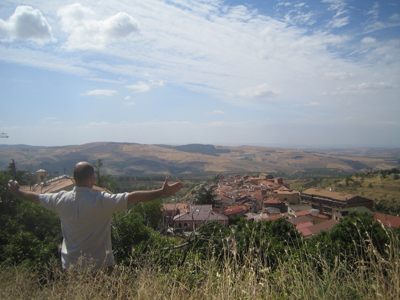
But first an aside on the length and substance of this post. Long before the trip I had been wondering about the right format to present the adventure. I considered offline entirely, as an article-length or even book-length travelogue. (Haven’t ruled that out, of course.) But then I love on-the-go posting about travel in real-time so the blog seemed ripe and available … and did not require an agent, publisher, or a contract. And yet, as the trip got closer I started to worry about the downside of immediate publication. You know, the lack of any kind of critical distance from the events, the possibility of being offensive to someone who I’d have to apologize to in broken Italian, things like that. And then: the trip started and the the ‘tubes were disconnected. I had no connection until the very end of the trip, except for the iPhone — and you can be sure I was not going to post a novella from that. So here we are. Eight days and one meaty post. Not exactly an espresso. More of a caffè (molto) lungo.
Sections
- Once Upon a Time
- Escape from Naples
- La Costiera Amalfitana
- Journey to Mount Vulture
- “Fellow Citizen”
- Ancient Lucania
- Ciao Ciao
It began with an e-mail out of the blue. A man named Michele Brucoli contacted me over a year ago. He works for the government of the region of Basilicata in Italy. (There are 20 regions in Italy — Tuscany is one for instance — each divided into provinces.) Basically Michele does economic outreach — promoting tourism, agriculture, and products from the region around Italy and around the world. He had found my website and its infrequent musings on the land where my great-grandparents emigrated from in 1903. We wrote back and forth for months. He sent me a huge box of promotional material. It was fun, diverting.
But then Michele contacted me to say that my family’s hometown of Barile was planning a ceremony to present me with an award. They wanted to know if I would come back and accept it. First thought: absolutely! Second thought (following approximately three picoseconds after the first): what the hell? What have I done to deserve this? But the clock was ticking. The window was narrow. I’d have to come over in July. To make things trickier, a close friend named Roberto Di Tolve was bringing his family back to Barile from their home in Holland for a summer holiday. I’d known Roberto for years and had toured Barile with him in 2003 and I knew that things would go much more smoothly if he were there. He was born in Barile and spoke Italian fluently. I needed to synch up with him.
So I had to shelve the larger questions of what the award was all about to deal with the practical reality of getting a trip booked. Oh also, I invited my parents. And this complicated things quite a lot. The trip got planned, though I still wasn’t entirely sure what was going on. But who cared? I was going to Italy.
Enough preface. Andiamo.
We departed for Naples, the same port my great-grandparents left from in 1903. This required a route through Milan from Chicago on Alitalia. I used to love Alitalia, but … I no longer love Alitalia. The planes are decrepit. Frighteningly so. I travel overseas enough to have a rough sense of the the state of planes and, wow, these suck. They look like they have not been overhauled in 15 years. Little bits of food stuck in the tray table pocket. Fraying fabric. Lavs with barely any toilet paper. I shudder to think what the maintenance of the really important parts of the planes is like. Also, four years ago the female flight attendants wore black leather gloves. I considered this naughty and very cool. They no longer wear these gloves. I consider this very disappointing.
On our flight was an Albanian bride-to-be traveling to Italy with her American fiancé. She had an entire luggage bin for her wedding dress. If you’ve read the pre-trip post about the Arbëreshë you’ll know that meeting an Albanian on our flight to Italy seemed strangely right, in a this-is-only-the-first-of-the-nutty-coincidences-isn’t-it? sort of way.
In Naples I got my first good look of my parents’ luggage. It was cause for worry. But let me back up. Prior to the trip I asked my parents to do three things:
- Set your expectations low.
- Learn the Italian alphabet.
- Pack in a single suitcase.
They accomplished the first and were pleasantly surprised with how the trip turned out. I asked them to learn the sounds of the Italian alphabet (which with very few exceptions is only one sound per letter) so that they could sound out words and pronounce names of people we met. They did not do this, as you will read. But the last request was by far the most important because, well, we were going to be driving around in this Lilliputian automobile. They adhered to the letter of the request, if not the spirit. The bags were big. We were packed into the car so tightly — luggage occupying every volume not filled with flesh and bone — that our own bodies started to assume the inverse shape of bags, like Tetris pieces.
We had no plans in Naples, except to get the hell out, fast. Naples, if you’ve never been, is actually a ongoing demolition derby of maniacal drivers and death-wish scooterers masked to look like a city. It makes Rome look like Pleasantville. I sorta knew how to get to the Amalfi coast, having done it four years previously. (Just keep Vesuvius on the left. Simple.) I had a map, sure, but the street grid is not a grid at all but an implausible, organic mashup of negative space between immovable structure. Also, I lacked a real navigator. On my previous trip I had my brother and a GPS-enabled PDA. On this trip I had only my mother in the backseat struggling to breathe amidst the ribcage-crushing luggage and my father who required a full stop and several minutes to study the map if I had a question. As anyone knows who has driven in Naples, you cannot stop. Ever. But … I did have my iPhone with maps on it. So, picture this: driving in a town I do not know amidst drivers whose reason for existence is to make sure I know that I am an idiot, if not to outright kill me — all while trying to glance at the iPhone which very definitely requires two hands.
Dad was stressed. His utter silence and tense body radiated panic in the face of loss of control as I careened us through the streets. Mom was stressed, sensing an impending yelling match between the two men in the front seats and trying to figure out how to mediate it before it happened. Which of course it did.
We made it eventually and in a seeming instant the chaos of Naples dissolved into the sublime beauty of the Amalfi Coast.
The Amalfi Coast was a concession. To be sure it is breathtaking and unique, but my father and I had already been and it isn’t exactly the most direct route to Basilicata. But my father is a romantic and apparently was not sufficiently romanced by a trip down the coast with his two sons in 2003 so he insisted that we spend a little time there with my mom. At least I knew where I was going. Hard not to. There’s a single two-lane road that hugs the cliff all the way from Sorrento to Salerno. The buzz of scooters flying past was only interrupted with gasps of terror from my mom in the backseat. I recommended that she just close her eyes, but the unbelievable scenery — cerulean sea, craggy cliffs, heartbreakingly adorable villages — demanded that eyes remain open. Poor mom. It truly was a deathrace. Have a look at the video if you don’t believe me. (Yes, there is a cut when I almost got creamed by a bus. Had to hyperventilate.)
Our destination on the coast was the Hotel Villa Maria, a small, gorgeous albergo tucked into the upper reaches of Ravello, itself a town plopped high on a hill overlooking the Gulf of Salerno. To get there you basically drive your car until the streets narrow so much that you can no longer move forward. Then you call the hotel and they send some former stunt driver down to move your car into the parking lot. I did not do this and ended up being glad I got the damage waiver from Avis. The hotel is the former residence of Gore Vidal. And you do feel like it would be the perfect place to write a novel. Except that the view from the terrace is all-consuming. It’s like Olympus up there, looking down on fruit orchards and tiny villas hanging off cliffs as wispy clouds drift down to the sea.
In Ravello, our first night in Italy, we were met for dinner by Silvana D’Auria and her husband Ermano. Truly lovely people. Silvana, an IBM colleague from my Hermitage days, lives outside of Salerno. I found it strange to think that she actually lives on the Amalfi Coast amongst such extraordinary views day-in and day-out. Does it ever get old? I bet not. I’ll say only that it makes a huge difference to have dinner with friends on the first night of an international trip. No fussing over untranslated menus, no worrying about jetlag, just a comfortable easing-into the journey.
Well, there was fussing — the first of many tragicomic moments where the Italian language and culture hit my thoroughly American parents squarely in the face. They tried hard, I will give them that. But that trying included not having a clue about the Italian language. So there wasn’t much to try with. The problem was that if anyone spoke even a little bit of English my parents would switch to full-on, high-speed, idiom-laden American English. Which is exactly what would happen in reverse when I spoke my limited Italian to a fluent native — so I can speak about what it is like from the receiving end. It stinks. You could see it in the faces of the Italians when my parents would use figures of speech that left them, well, speechless. I tried mightily to get my parents to slow down and pare back all non-essential phrases, but it never really took. They were so happy to encounter anyone speaking English that it was like a floodgate crashing open. It should be said that my parents are naturally communicative, personable folks, so this was only natural. But damn there were a lot of befuddled Italians left in our wake.
I went to sleep with the window open and was greeted with the smell of the lemon orchard outside my window when I woke.
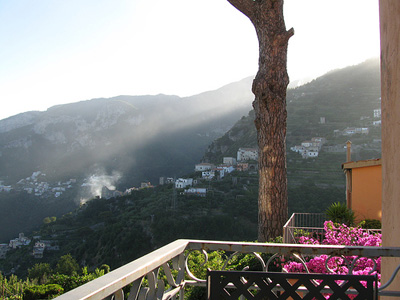
We poked around Ravello’s main piazza, got lost trying to depart, and decamped for the town of Amalfi. Amalfi, the former medieval maritime republic, is at sea level unlike most of the hamlets on the coast. This funnels the roadway right down through the throngs of beachgoers and tourists. It was Saturday morning and it was mayhem. There was absolutely no place to park and, worse, no place to stop or turn around. You had to drive fully into and out of the town in order to turn around and try again. This we did perhaps six times. Then I made the decision to dump my parents on their own for sightseeing. It felt like such a wrong thing to do so early in the trip but also so very very right. I needed a tour guide break. I shot out of Amalfi alone towards Positano to retrieve a ceramic patio table my Dad had coveted the day before. As I drove I convinced myself that they were adults and could handle things alone. What could go wrong with them all to themselves? Well … about twenty minutes later I got a call from the Amalfi head of the Carabinieri police force — no, no just kidding. They did fine. See above, befuddled Italians left in wake. A few hours later I swung back through Amalfi, snagged my parents, and we began our journey away from the coast and into Basilicata.
I guess I was just intoxicated to be off the coast on the open road of the A3 autostrada — and happy that my mother was no longer palpitating — but this sense of freedom got us fantastically lost. Well, not lost. I knew where we were, heading into Calabria rather than Basilicata. Just not where we should have been. We stopped at a gas station (with a stunning view of the town of Sala Consilina) so that I could study the map. In a way, these highway-side gas stations seem very American. Not sure why. But I think it did for my father too because he went inside to get a cup of coffee thinking, I’m sure, certainly I can get a cup of “real” American java at a gas station! He thought wrong, of course. See, my father loves coffee in the most American style: in great, dilute volume. To him, coffee is as much a social accessory as it is a beverage — something to be paused over, contemplated, and repeatedly refilled. He simply refuses to pound a shot of high-octane espresso. But he suffered in silence this time having spent much of the last trip to Italy being jibed by my brother and I. He basically opted for a cappuccino whenever he wanted a coffee. (Despite some waiters surprised at the order. In Italy it is mostly a breakfast drink.) Poor dad. Even the caffè lungo was not lungo enough.
We got back on track and headed north into Basilicata. The landscape becomes harsher as one heads away from the coast. The land is more arid and severe, beautiful in a way completely unlike the vistas on the water. It isn’t desolate so much as untamed. I saw no wild boars prowling about, but when I looked into the overgrown ravines I felt like I was being looked back at. Humans stick to the hilltops. Terracotta-roofed houses form towns perched on limestone-white hills, like a cardinal’s zucchetto.
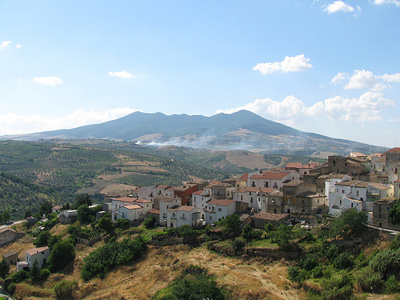
Our destination was the area known as Vulture for the ginormous extinct volcano of Mount Vulture which dominates the terrain. As you motor up from Potenza, the provincial capital, you keep thinking that the looming volcano will pop into view at each turn. But when it does it is still surprising in its immensity. Vulture blew itself to smithereens eons ago — a good thing, too. The highly regarded Aglianico del Vulture wine grape grows best in the rich volcanic soil that rings the mountain. In fact, the Aglianico del Vulture wine is on the verge of receiving the rare DOCG appellation from Italy, roughly equivalent to the prestige/legal protection that Champagne receives from France. (Gotta call it sparkling wine if it isn’t from the province of Champagne.) Still, the Vulture region is seismically active as it stewards the tumultuous marriage of the Eurasian and African tectonic plates. Most buildings show evidence of after-the-fact structural reinforcement.
Vulture was an epicenter for us too. Barile, Italy, sitting on a slope of the volcano, was our real goal. Barile, of course, was the hometown of my great-grandparents and the reason we were making the trip at all. When I studied in Rome in 1993 my friend Matt and I made a crazy trip to Barile. Crazy in that we didn’t know what we were doing, how to communicate, or where to stay. We got there during siesta and thought it was an abandoned town. (Don’t laugh. Nearby Craco is precisely that. Everyone had to leave after part of the town just slid off the side of the hill it was clinging to.) But that trip in 1993 — and especially the warmth of the people we met there — started a relationship with the town that obviously was blossoming into a full blown affair.
Barile (ba-ree-lay) means “barrel” in Italian. No one knows why it is called that exactly. Though a winemaking town named barrel makes some sense, the fact is that it was founded before it was surrounded by vineyards. Who knows? But you have to love the town seal with the Virgin Mary and Child sitting atop a cask of wine.
I planned this trip pretty well, I have to say. But I forgot a few key things. Such as, oh, knowing where exactly the hotel in Barile was. See, there are no hotels in Barile. But there is a brand new one just outside of Barile. And that is all I knew about it. I had an address, but it was a kilometer marker not a real address. So, as was becoming traditional upon arrival or departure of any municipality in Italy, we got lost. Just drove around looking for something outside the town that looked hotel-y. Once we found it we checked in and dumped our stuff. The desk clerk said in broken English, “So you’re from here?” Less a question, more an accusation. “Well, my great-grandparents were from here.” The look I got back transcended language. I translate here precisely: So why the hell did you come back?
There were some messages waiting for me from the town. Apparently it was not all an elaborate joke. They really wanted me there. Or perhaps it was an elaborate joke and I was too dense to get it. Eh, whatever. Time to eat.
We had been invited to have dinner in Ripacandida, one hilltown over from Barile. How this invitation came to be is indicative of the wonderfully compact social network that is southern Italy. See, part of the promotional material that Michele Brucoli sent me many months before included a book on all the restaurants that served Basilicatan (called Lucanian) cuisine around the world. There was one entry for Chicago, Anna Maria Pasteria, so I figured I’d try it out. As I was leaving the restaurant I thanked the hostess, Maria. She was actually the owner and, when I mentioned my name, she said “Oh, Tolva! Are you related to Mike Tolva?” Turns out her mother was the cousin of my great-aunt. She and her siblings grew up with my Dad’s cousins in Blue Island. But they were first generation immigrants from Ripacandida and one of Maria’s sisters, Madaleine, still lived there. This is how we came to be invited to a person’s home for dinner on our first night on Vulture.
Having lived in America for many years, Madaleine spoke near-perfect English. Her husband and daughter, virtually none. Believe it or not, some family from Chicago were visiting too so the table was aflutter with both languages. Madaleine, called Lena, fixed a wonderful meal of traditional dishes including a stunning ravioli with sweet filling. The wine, of course, was Aglianico. We got to talking about Ripacandida, a town also known for its wine but which exists somewhat in the shadow of the nearby towns. Though to an outsider most of these towns must look and feel the same, there is a latent competitiveness and effort to differentiate them that comes out in conversation. The competition is ultimately for money — wine revenue, tourist dollars (er, euros) such as exist, and industry attention.
For instance, Ripacandida is very proud that American actor Gary Sinise’s family comes from the town. They are trying desperately to contact him to see if he will come back and put Ripacandida on the map. They are looking at the example of Francis Ford Coppola who returned to his town of Bernalda with much fanfare … and investment. (Poor Barile, all they got was me.) As a travel agent Lena is particularly attuned to the outside perception of the region. She says she’s invited travel agents from around Europe to visit Vulture for years and not a single one has taken her up on the offer. Lena’s agency provides a variety of packages that feature wine, food, hiking, and literary itineraries. Still, I get the sense it isn’t a booming business. The attractions are there, but the tourists aren’t. The word simply isn’t getting out.
My invitation to return to Barile was beginning to make more sense.
It was late for jetlagged folks, 11:30 PM, but we had to meet up with our pal Roberto Di Tolve and his family back in Barile. Roberto was born in Barile, but left as a teen to work in Holland and never looked back. His cousin, a precious octogenarian widow named Anita, still lives there and in 2003 we joined him for a return to see her and the town, his first in decades. We’re probably related, somehow, but we’ve not figured out how. I’ve found it fairly typical of Europeans to be relatively ambivalent about genealogy. This is absolutely not the same as being unconcerned with family; Roberto is one of the best fathers I know. But there’s a kind of so-what mentality amongst Europeans: family is how you define it, not what the church records and bloodlines say it is. Despite my recent obsession with genealogy, I would leave Italy firmly subscribing to this outlook.
It was a late Sunday night, but Barile was alive. The main piazza still had people milling about the community fountain and the cafes (all two of them) were filled with late-night caffeine-seekers. We parked by the fountain and were greeted by Roberto, arms outstretched. It was a wonderful moment. From an unsolicited “hey we have the same surname” e-mail Roberto sent in 2002 — to this. I had met Roberto twice before, once in Barile and once at his home in Holland, but this was different. He was greeting my parents and I as a concittadino, a citizen of the town, and it was at this moment that I knew I would never make it through my prepared statements at the recognition ceremony without an emotional stumble.
Roberto’s sister and cousins Pino, Pasquale, and Maria Sciaraffa, Barile residents all, greeted us like long-lost family. None of them spoke a word of English, but it truly did not matter. There are some feelings of belonging that exist outside of language (actually most feelings of belonging probably exist outside of language). The warmth at that cafe table was so damn genuine that even my parents, adrift in the Italian washing over them, were perfectly content. My mom made fast friends with Maria through nothing more complicated than synchronized chortling and much touching. It was bizarre but strangely so right. Roberto’s teenaged sons, whose English is impeccable, were there also. In America teenagers witnessing this transcultural lovefest would have been doubled over in embarrassment and misery. But not the Di Tolve boys. They joined right in, serving as accidental intermediaries when something precise actually had to be conveyed across the table.
If the trip had ended right there I would have been completely pleased. But it was only a taste.
We slept in a bit the next day, composing ourselves for the upcoming events which were still a big mystery to us. Even at this eleventh hour I had not given the “why” part of it all a sufficient think. But at this point I had resolved simply to forget about why they were honoring me and to focus on the honor itself. This town had planned something and by god I was going to make them glad for doing it.
11:00 AM Barile Town Hall. Nothing but a clock tower on the building to indicate that this was an important building. Men milling about in the passageway behind the mayor’s office. My parents and I are shuttled in before we can say or do anything. The mayor’s office is packed with people. I am thrust to the desk and introduced to the mayor, a man who shares the same surname as my great-grandmother. Mayor Franco Botte. Barile is so small and so old that there are a handful of surnames that simply persist. It is likely Franco and I are related, but it would take some digging. Of course, if Franco and I are related then so am I with Mike and John Botte of New York. Mike Botte contacted me (again out of the blue) by e-mail a few months before the trip inquiring about my lineage. Turns out that his cousin is the mayor of Barile. So there was a connection before I set foot in town.
Before the mayor spoke a representative from Potenza (sorta like the county seat) stepped up and spoke about the Lucani nel Mondo, or people of Basilicatan descent living abroad. My translator was practicing extreme data compression so I didn’t get a great sense of what was being said. In fact, had he not been talking in my ear I probably could have understood much more. When the remarks were over I was presented with a gigantic, well, chalice. Part trophy, part fraternity binge-drinking prop. It was awesome. He also recognized two Italian immigrants who had settled in South America, one in Argentina, one in Venezuela, who had come back to Barile. They were the heads of various Barile-specific community organizations. Buenos Aires alone has 400 Barilesi families. That’s amazing, when you think about it. I felt a bit sorry for the South Americans though. All they got were small keychains while I was in possession of this World Cup-caliber trophy.

The mayor then made some remarks and presented me with a copy of the town seal and a great plaque which bestowed on me the honor of “fellow citizen.” It didn’t make me a member of the EU, but it made me damn proud. I pulled out my prepared remarks and read in halting Italian.
Amici e parenti, vi ringrazio molto per il vostro sentito riconoscimento che voi state dando a me e alla mia famiglia. Sebbene viviamo negli Stati Uniti a Barile ci sentiamo come a casa nostra. Farò tutto quello che rientra nelle mie possibilità per promuovere Barile e la Basilicata. Per cui, per conto della mia famiglia e di tutti quelli che vivono a Chicago e provengono dalla Basilicata, vi ringrazio di cuore. I lucani nel mondo saranno eternamente debitori per quello che ci avete dato. Come si dice in Arbërisht: Ez me shëndet. Rrim mirë.
[Friends and family, thank you very much for your kind recognition of me and my family. Though we come from the United States we feel that Barile is also our home. I am personally committed to helping Barile and Basilicata in any way I can. So, on behalf of my entire family and all Chicagoans of Basilicatan heritage, I say thank you. The lucani nel mondo owe you a huge debt of gratitude for what you have given us. As they say in Arbëreshë: All the best. Take care.]
That last sentence is actually in Arbërisht, the time-capsule variant of Albanian spoken by descendants of the refugees who founded the town in the 15th century. I had been contacted before the trip by Luigi Boccia, webmaster of Jemi.it, the biggest Arbëreshë resource on the web. He was kind enough to translate this phrase and even to provide me with sound files so I’d know how to pronounce it. Have a listen.
I was nervous and I lurched through the remarks, but the crowd was following me and I could hear them helping me with difficult words. It was rather moving, honestly. They were clearly happy that I was addressing them in Italian and they wanted to help. Some light-hearted dialogue ensued. I was following the conversation on my own now, but with about a five-second delay between what was being said and what I was understanding. This was a problem as at one point the mayor offered to arrange a wife for me in Barile. Everyone laughed and so I laughed too so as not to seem out of place, and only then did I figure out what had just been said. Wait a minute! That’s going to be a bit of a problem, I said, pointing to my wedding band. I never did get to ask who they were thinking of hooking me up with. Which added a curious new dimension to each woman I met thereafter in Barile.
I presented the mayor with a book of vintage postage images called Greetings from Chicago, a gift for the town of Barile. It was a trivial thing really compared to the Chalice of Destiny, but he took it very seriously and made a big deal about placing it in his bookcase of leather-bound tomes. The ceremony splintered into numerous groups as wine and foods were brought out. I finally got a chance to say hello to some of the people in the crowd, including the town priest Don Giuseppe Cacosso who had shown immense patience with my brother and I in 2003 as we pored over yellowing records in the church library. The main clerk at the municipal records office, Mario Giuliano, was also there. He explained to me that he was on holiday at the seaside but came back to town specifically for this ceremony.
The crowd dispersed and my parents, Roberto and family, and I made our way through the streets to Anita Di Tolve’s house. Anita is a gem. Her husband died a few years ago and she’s been observing the traditional mourning ritual ever since. She wears all black (in 2003 she was distressed not to be able to find her black stockings when we took a trip to the cemetery because she was worried that the townspeople would gossip) and she has not slept a single night in her bed since her husband passed away. (She sleeps on a couch downstairs.) When family is in town she’s happiest, spending the entire day prepping and cooking in her tiny home. Dishes in Basilicata are simple but wonderful. She made us the most satisfying meal with the most basic ingredients and equipment. It followed the typical Italian sequence: pasta, meat, salad, fruit, dessert. Wine throughout. (“Family style” Italian where a gross ton of pasta is plopped mid-table seems to be an American invention.) Roberto and company mocked me as the town VIP. Just like family.
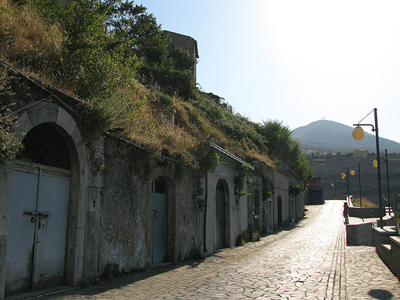
Sweet Anita needed her siesta nap (her couch was in the kitchen) so we made a quick pit stop back at the hotel and were soon back for the second half of the day’s activities. The town promotional agency, called the Pro Loco, had arranged a tour of the sassi caves that line the ridge beneath Barile. The history of the sassi is one of shame turned to pride. As late as the 1950’s some families in the town lived in these caves. They had no electricity or running water, of course, but they are amazingly cool and of course make wonderful shelters. Impelled in part by the public outcry over Carlo Levi’s Christ Stopped at Eboli which exposed the plight of the poverty-stricken south, the government of Italy undertook a concerted effort to raise the standard of living. Families were moved out of the caves and into new residences. But they retained ownership of the caves and, over time, the sassi became cantine, or wine cellars. Some look abandoned and frightening, some are for storage only, but most are small personal wine-making dens. Some of these have been refurbished with terraces and brick ovens. It is a sight to behold, especially with Vulture looming in the background and a sheer drop to the ravine floor on the other side of the narrow path linking the sassi.
We trotted down to one of the cantine that had been opened especially for us. Our crowd of about twenty people piled into the small cave and marveled at the equipment, the sheer quantity of homemade vino, and most of all the striking coolness of the place. It was at least 15 degrees cooler in there. It was cluttered but orderly. Dank and musty. The owner of the cave, a tiny man, flitted around plucking bottles here and there — none of them labeled, but all of them different apparently — and poured us all samples. This immediately brought me back to 1993 when Matt and I befriended a guy named Lorenzo on my inaugural trip. He took us to his sassi, beckoned us in, and poured us some of his hooch. It was then and was at the moment the defining act of being in Barile: wine in a cave with complete strangers but total camaraderie.
Back in the present the cave owner ushered me to the rear of the cave where he tapped a large vat of red spumante. He poured; I drank. Only then did I notice a spider in the glass. Obviously a spigot stowaway. I considered just chugging it down so as not to embarrass the man, but instead I turned it into an opportunity to improve my Italian. I pointed at the sodden arachnid and said “Come si dice?” He answered (spider is ragno in Italian) but looked at me like, well, are you going to drink it or not? I drank it.
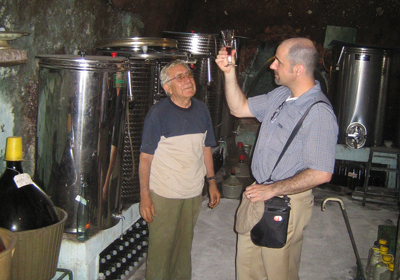
The sassi of Barile are not a tourist attraction like the more elaborate sassi of Matera. But they are the town’s defining characteristic, providing a direct, tangible link to the past. That these symbols of shame from the last century could be transformed into such functional and beautiful examples of the town’s new vitality is cause for hope. It is not such a stretch to imagine organized tastings of private stock Aglianico (call it “sassi-hopping”) as the sun sets over Vulture. That’s a tourist experience you won’t get anywhere else.
Michele Brucoli showed up with his young son. This of course immediately made me homesick for my wife and kids back home, the only part of the trip that was at all depressing. It just didn’t seem right that I should be experiencing all this without my family. But the kids were too young and, well, the people we’d trust to watch the kids if my wife were to accompany me — my parents — were here with me. Just gives me an excuse to come back, I kept telling myself. Gotta show the family.
The group — dare I call it an entourage? — hiked back up from the cantine into the town center for the main show, the Pro Loco ceremony. There were flyers all over town promoting this event, the public counterpart to the private ceremony in the mayor’s office. The Pro Loco is really just a single room off the “main” street which connects the central piazza to the town hall. The walls are lined with historic photographs, flags, and awards. Cabinets are stuffed with promotional material (all in Italian) and sundry artifacts. Townsfolk straggled in and before long the room was full. The dinner guests we met the first night in Ripacandida made the trip over to Barile and sat themselves in the front row, as if I had known them forever. The evening passaggiatta — the traditional post-siesta strolling of the streets when the heat has abated — had begun and the streets filled up. Curious onlookers peered in from the street.
I was seated at a table at the front of the room with members of the Pro Loco, a representative of the wine consortium, and others whose role I never determined. They all made short speeches about how proud the town was to welcome home a relative. They mentioned some of my work on cultural heritage and thanked me for my efforts to promote the town and region. Only the day before did I learn that there would be two separate events so I had not prepared remarks for this ceremony. But I felt that I needed to say something. So before the wine and food was pulled out I asked to speak. Extemporaneously, but thankfully in translation. I’m not sure exactly what I said — I was in a bit of shock I think, or maybe it was the moonshine, or maybe it was the spider — but I remember mentioning how small the world had become thanks to technologies of transportation and communication. I said something about how much the world owes to the immigrants from southern Italy in the 20th century. I thanked the town profusely on behalf of my parents and siblings. And I remember getting choked up about it all and having to stop. Which made my mom cry.
And then came the prodotti tipici, or local goods: wine, cheese, meats, and pastries. Oh, and wine, lots of wine. This might qualify as my favorite part of the whole trip. The passaggiata was in full swing as we spilled out onto the cobblestones, talking, drinking, and laughing. My parents were having a great time with the townspeople and I was mobbed by people who had read about the iPhone on my blog. (Even in this remote little town people had heard of the iPhone and wanted to play with it. Say what you will about the iPhone, but it is a perfect facilitator of social interaction. Visual and tactile, language not necessary. The predictive text did however do hilarious things to my Italian text-messaging.)
I’m not sure how long we were out in the street chatting, but I met dozens of people. One woman said, “The whole town has been talking about you for a week, wondering who you were and if you were related to any of us.” You can read that in a few ways, of course. The simplest explanation is that people were simply wondering (like I was) what the heck was going on. What’s the fuss? He’s no Francis Ford Coppola! Hell, he’s not even Gary Sinise. Whatever the reason, it isn’t far-fetched to think that the whole town was talking about us. The most common sight in Barile are streets lined with older men just sitting around, seemingly doing nothing. But of course they are talking. It is the prototypical social network and it is far faster than the Internet. Word travels fast.
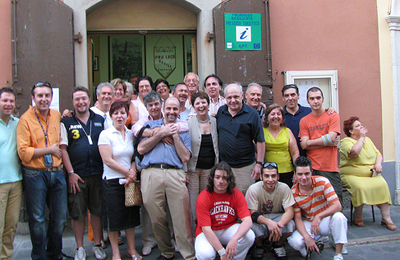
I met a group of younger people who had set up a storefront just down from the Pro Loco. They were independent publishers of a magazine on the town and its issues. This was very encouraging to me. Not only had I not seen many young people at all on previous trips, but here were kids who had taken it upon themselves to write about their place. Though much of the writing was critical, the fact that they were doing it at all suggested that they at least cared about Barile. Perhaps the flight of youth to larger towns was slowing?
Our group moved to the cafe where the owner brought out gelato and limoncello. Hardly twenty-four hours had passed since we arrived in Barile, but there hadn’t been a moment that was not extraordinary.
The next morning, still in disbelief at the events of the day before, my parents and I swung by Anita’s house to pick up Roberto and his sister Anna. Anita was sitting on her couch making homemade pasta called “preachers’ hats”. Sorta like orecchiette. She was lightning fast. My dad wanted to learn so he sat down and mangled a few bits which I am certain Anita composted and reworked after we left. It was a cute scene though. Earlier than morning Anita and Anna had made biscotti from scratch. Then they ambled to the town bakery where the biscotti were finished in the large oven. This is a common thing and a holdover from the days when few people had their own ovens. (Anita has one, but is easier to finish the biscotti at the bakery.)
Anna, Roberto, and my family piled into the car bound for the lakes of Monticchio. Then we got lost. (You should know the pattern by now.) Back on track we headed up the side of Vulture. The volcano caldera contains two pristine lakes and makes a great hike. An imposing, mute monastery pokes out from the forest above the lakes and makes the whole place seem even more serene. The lakes are dark and still, which would suggest that they are very deep. If Italy has a Loch Ness-type monster it most likely lives here. The hike was wonderful, a pleasant natural counterpoint to the pomp of the previous day. We did a full circuit of the small lake and ascended to the monastery where we saw not a soul (living or dead). Anna and my mother chatted the whole time, though neither spoke the other’s language. We returned to Anita’s for lunch and ate the very same pasta that had been hand-shaped only a few hours before. Funny how much better something tastes when you’ve witnessed it prepared from scratch.
We left the Di Tolves at Anita’s and set out to return to Ripacandida, this time in daylight. Lena wanted to show us around her town. Ripacandida may command the best view of Mount Vulture of any of the towns since it is not on the slope but perched high on a hill nearby. As such the streets are vertiginous and narrow, Ravello-esque. Mom was back to white-knuckling the “oh shit” handle in the backseat. The highlight was a visit to the small Church of San Donato. It is covered with well-preserved frescoes and has a charming garden and maze in back. As in Barile, men sat in rows along the narrow roads unabashedly staring at us as we passed by.
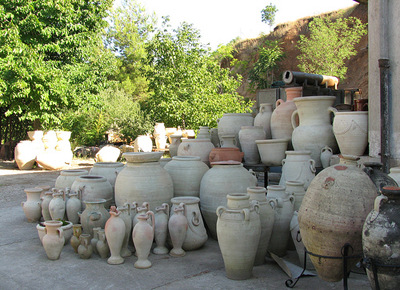
From Ripacandida we set out for the town of Venosa, birthplace of the Roman poet Horace. Venosa is a metropolis compared to Barile and Ripacandida. Being a Roman town Venosa has a much longer history and reminds you that even in the hinterlands the Roman empire had thriving outposts. In a way the Roman ruins seemed out of place. Vulture and most of Basilicata is a pastiche of cultural influences deposited by whatever empire was currently in the ascendancy on the Mediterranean. But it rarely feels Roman, which I take to be a good thing. Why come to Basilicata if all you are going to see is more of what you’d find in Verona and Herculaneum? Still this isn’t Roman overload. Venosa actually radiates outward from a beautiful Aragonese castle and feels more medieval than anything else.
Lena’s travel agency is headquartered in Venosa so we paid a visit. But the real purpose of our visit was to be taken to a ceramics “laboratory” and shop on the outskirts. My father had been looking for a typical kind of unadorned ceramic jug ever since he spotted some in 2003. The Internet had been no help. Lena assured us that this shop would have what he was looking for. And it certainly did. We spent way too much time perusing the shop only to find out that a) the owner who spoke no English took only cash, b) he did not ship internationally, and c) Lena had to leave us to go to work. That left the four of us to try to figure out how to get these jugs back to America. We’ll see if they ever arrive.
Dinner that night was at the hotel, just my parents and I. We hardly knew where to begin in recounting what had happened to us since we arrived. Luckily we didn’t have to, as Roberto showed up for an espresso. We retired to our rooms and toppled into our beds like so many giant ceramic jugs.
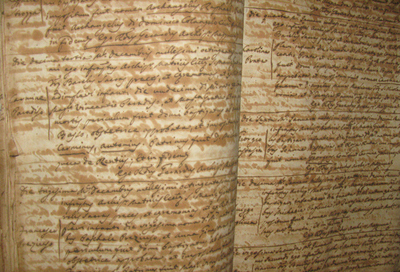
The next morning we gathered at Anita’s again to say goodbye to everyone. The head of the Pro Loco, Lorenzo Gagliardi, stopped by in his work clothes. Which is to say, he came by in his painter’s overalls. He paints houses by day; runs the town’s promotional agency by night. I loved that. The farewell was long and loud. Much hugging. Lots of imploring to visit Chicago. Lots of promises to return. I was truly sad to be leaving.
But there was one last thing to do. Don Giuseppe, the priest at the local church, had spent the last evening poring through baptism, marriage, and funeral records for me based on family tree information that I had sent ahead of time. Roberto and I popped into the church office and were greeted with stacks of books marked with small pieces of paper to indicate relevance to me. The effort Don Giuseppe put in was staggering, especially given that all the records are in ecclesiastical Latin script and that so many of the names and surnames of my ancestors were commonplace. We had to get on the road for Potenza so Don Giuseppe promised to e-mail it all to me (which he did as a set of annotated scans — wow). We bid farewell, I dropped as sizable a church donation as I could on his desk, and we were on our way out of Barile. I wasn’t all that sad, frankly. This was the first time I ever left Barile with absolute certainty that I would be back.
Destination: Potenza. About an hour south of Vulture. There we were to meet Michele Brucoli and begin the final part of our journey with a meeting at the regional government offices. We got lost, of course, but it was a pleasant lost. Like being just a little bit mentally deranged. La la la. Lost was an old, comfortable pal at this point.
Potenza is a big town, at least by Basilicata standards. It’s charm has been consistently annihilated over the centuries by vicious earthquakes (and Allied bombing runs in WWII to seal the deal). In fact we had lunch in an odd part of town at a restaurant originally slapped together in 1980 to feed a temporary housing camp of residents whose houses were leveled by the earthquake of that year. The barracks are still there and still occupied. Potenza also holds the dubious distinction of recording both the coldest and hottest temperatures in Italy annually.
The meeting in Potenza was the first of my more “official” duties in Italy, if you can call them that. I spent about 30 minutes talking with Rocco Messina, president of the office of internationalization and image promotion (my translation), and Pietro Simonetti of the regional commission of Lucanians abroad. They told me of their plans to create a museum of immigration in Basilicata, possibly in the wonderful castle at Lagopesole. A Lucanian “Ellis Island” is how they described it. They also described the diffuse Lucani nel Mondo association worldwide and noted that the office in Chicago could use some help. I took some pains to make sure it was known that I was there on my own and not as a representative of IBM, which they seemed to understand, and I pledged to help in any way I could. I mean, if Chicago can have a National Italian American Sports Hall of Fame then why can’t Basilicata have a museum about all the people who have left it? I was presented with a little lapel pin of the Basilicatan flag and my parents were given a reproduction of an ancient Lucanian coin, which they absolutely adored.
From Potenza we headed across Basilicata following Michele (thus we did not get lost) and into Matera province, the other administrative half of Basilicata. The tectonic rift here produces stunning terrain, not unlike the American Rockies. It is also more lush. We rolled into Matera in mid-afternoon just as it started to rain. Which only added to the bizarreness which is Matera, Italy. It is called the oldest continuously inhabited city in Europe, already ancient when Rome was founded. Matera is basically a city carved from stone. Where in Barile the sassi are quaint adjuncts to the town, in Matera the Sassi (which earn a capital) are the town. It is nearly impossible to determine where a cave ends and where the “house” built on in front of it from the same rock begins. Structures are jumbled onto one another in dizzying geometries, the roof of one cave serving as the terrace of another. It is the city M.C. Escher would have designed if he were an urban planner. The beauty of the hellishly complex, like living inside an algorithm.
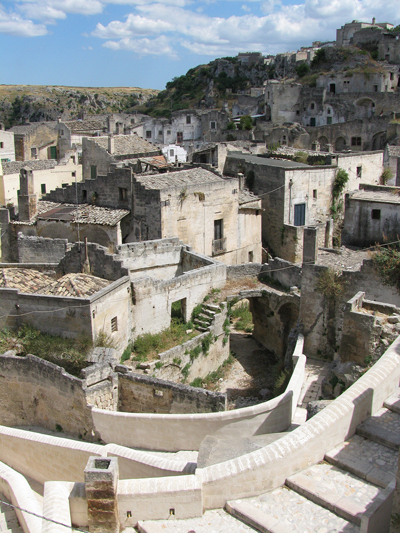
Matera is an example of a town in Basilicata that has had some success with tourism and industry. The Sassi and related rupestrian (rock-hewn) churches around the town are designated World Heritage sites by UNESCO. Much effort has been put into the Sassi to make it attractive and even livable. There’s electricity, running water, all public infrastructure. In fact, there is an ambitious plan to flood the entire Sassi with WiFi. Challenging, sure, but perhaps not as daunting as running cat-5 through all that rock. As in Barile the 20th century residents (and their livestock) were relocated from the caves to new housing. But recently Matera has encouraged people to move back in. Newlyweds get first dibs. Townspeople are encouraged to obtain 30- or 99-year leases on caves for opening business, restaurants, and of course hotels.
Michele had arranged for us to stay at La Casa di Lucio, one of the best. It is exactly what you’d expect, if what you expect is near-luxury in hotel rooms carved from stone. Five-star spelunking. The little boy in me instantly loved it. I’m sleeping in a cave. I’M SLEEPING IN A CAVE! If you like your room dark at night, this is the place to come. It is tomb-like. Temperature is tough to regulate in there, but who cares … I was in a damn cave. And: they had a wicked fast wired Internet connection, the first of the entire trip. It was a bottle of Mad Dog wrapped in a brown paper bag and I was ready to fall off the wagon.
That evening we met up with Paolo Montagna, director of the Centro Educazione Ambientale (an education center specializing in the cultural heritage embedded in the land, such as the rock churches). With our superb translator, Chiara Farella, we set out as the sun was going down for the Crypt of the Original Sin, a large-ish rock-hewn church west of Matera. These churches are literally built into cliff walls which explains why so many went undiscovered for so long. We were at last able to convince my mom to make the short walk along the cliff face to the cave entrance. (Matera is truly a nightmare for claustrophobes, acrophobes, and those not sure of foot.)
The Crypt of the Original sin is so named for a series of amazing frescoes depicting the events in Eden. Interestingly, Eve is shown offering Adam a fig rather than an apple. The archaeologist with us explained that this is likely correct as it is believed that apple was a mistranslation from the original source. He noted also that apples are not indigenous to the Middle East. Mankind cursed for a fig.
The crypt itself has been cleverly wired with tiny high-power spotlights that progressively disclosed areas of the cave and scenes on the walls. A recorded narration (in Italian) guided us. The archaeologist also explained how the church was eventually located. Scholars knew it existed from documentation but didn’t really know where it was. They had been searching for weeks and were driving back from the cliffs one night when they decided to give a shepherd a ride. They explained what they were looking for and the shepherd said he thought he knew where it was. He used the cave as shelter for him and his flock at night. He would sleep on straw in one of the hewn apses and wake up with the painted saints looking down at him. Freaky. (Incidentally this is almost exactly how Machu Picchu in Peru was discovered.)
At some point around this time my mom delivered the most National Lampoon-esque quote of the trip when she asked for some translation help. I came over and informed her that the man talking to her was actually speaking English.
From the crypt we drove back into Matera to another set of rupestre. These caves were actually used as a convent long ago. And, not so long ago, as the setting for the Last Supper scene in Mel Gibson’s Passion of the Christ. Matera has derived a bit of fame from the movie, actually. It was an economic boon to the town and employed many townsfolk as extras. (Some we talked to complained about the drugs and prostitution that accompanied the Hollywood crew. Such sin!) You can easily see how Matera would make a perfect backdrop for a biblical story. Actually the whole region feels spookily possessed. The scene from the film where Judas hangs himself was set against the panorama of the abandoned town of Craco, mentioned above. Apt.
The rock-hewn convent was the site of a contemporary sculpture exhibition. I thought it quite well-done, giving new purpose to the caves and new context to the art. And for sheer drama you can’t beat encountering art in cleverly-lit cave niches. Our day concluded at the Baccanti Ristorante, a restaurant in the Sassi easily as high-end as its counterparts in Rome and Milan. Barile has none of these (though this comes close). Matera is a map for what Barile could be.
We adjourned to our cave-rooms. I wanted to stay up all night browsing the web, catching up on e-mail, clearing my feed-reader. But I couldn’t. The day that began in Anita’s kitchen, took us to the government offices of Potenza, and ended in rock churches in Matera provided a buzz I didn’t want to sully with the latest reviews of the iPhone and e-mail responses. I went to sleep. In a cave.
The next day, our last full day in Matera, began on the terrace outside our rooms and right next to a lovely little cafe. Paolo returned with tour guide Giovanni Ricciardi. We were bound for the other side of the ravine, the desolate terrain that faces the Sassi. On the way we stopped at a deep quarry where limestone for the construction and reconstruction of the Sassi was removed. It was like viewing a great empty bin of LEGO blocks. All the potential in that pit crafted into a make-believe city.
Next we set off for Paolo’s education center set squarely in the Murgia Materana, a protected park containing amazing views of the town and numerous rupestre churches. My parents and I were each given mountain bikes and we set out for the edge. Mom, of course, was unsteady and frightened, but she kept it mostly to herself and waited to see if we plunged over the cliff before making the next set of turns. The view of Matera from the Murgia is unmatched. From a single vantage point you take in the entire panorama from the Sassi Caveoso at the south to the Sassi Barisano on the north. You really cannot believe your eyes. The human structures are a life-size Photoshop filter pixellating the mountainside.
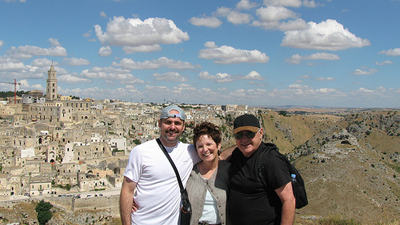
We visited the Church of the Three Doors where centuries of Christian graffiti etchings clustered around frescoes. Hard to imagine how much attention people could actually pay to the ceremony in these churches with the sheer drop right out the front door and the view of the ravine. The view itself seems more sacred and inspiring in some ways.
Back into Matera to visit the “new” town above the Sassi. The non-rock-hewn part of the town is quite fetching. We went to the central piazza and were allowed inside the massive, cavernous water cistern dug into the rock below. Collection of freshwater had long been important in Matera not only for drinking but because, in the jumble of cave and structure, channelling water smartly would ensure that you and your stuff didn’t get flushed into the ravine.
The cistern would be the perfect setting for a horror movie. It is unlit and we only had a few small flashlights. Their beams wouldn’t reveal whether you were standing over a 10 foot drop or a 200 foot drop. One moment you’re walking on a scaffolding inches above jet black water, the next you’re scooting along a vaulted, zagging walkway listening to your footsteps echo off stagnant water, somewhere.
A quick(ish) lunch of typical Materan fare and we were back to the hotel for the only real downtime of the entire trip. I needed some time to review the presentation that I had been invited to give that evening at La Scaletta. The topic was new media and cultural heritage, which was a bit open-ended. I had cannibalized some older presentations of my work in IBM and tailored it to what I considered the challenges unique to Basilicata. It was an odd thing, this presentation, being not a work engagement but feeling a lot like work — and with my parents sitting in the back. Layers of bizarreness.
The crowd was small but very engaged and curious. Chiara returned as the translator and did a great job with very dense material. I had sent her a list of difficult words (“modularity,” “watermark,” recontextualization“) a few days before so she would be ready for them. Turns out, they weren’t that difficult at all. The only word she had any trouble with was ”avatar.“ She knew the word, but only its original spiritual meaning. She was excellent, putting up with all my ingrained verbal tics and idiomatic style. The crowd seemed to get what I was saying and after the obligatory awkward silence once I had asked for questions I was engaged for a good twenty minutes of discussion. (The very first question — not kidding — was: can I see your iPhone?)
Matera has a mature understanding of culture heritage preservation and promotion. Other towns in the region could learn a lot from it, so I was honored to be asked to share my own experience. (Here’s the seminar press release, in Italian.)
From La Scaletta we visited a hotel under construction in the Sassi that had (surprise!) uncovered a rock church. When complete, one of the rooms actually would peer down into the long nave of the church straight at the former location of the altar. Matera had organized yet another contemporary art exhibition in these caves, complete with ambient sounds and ethereal lighting. They do like repurposing the Sassi here. Bravo.
We snaked through the warren of streets and came to our dinner spot on a restaurant terrace. Michele had arranged for his friends Gaetano and Mikaela Bandini to dine with us. They run Viaggi Lionetti, the most successful tour agency in Matera, and were a joy to meet. Gaetano is a Matera native; Mikaela is a spunky South African with flawless Italian. I felt immediately that if I were to assist Basilicata in some way, Mikaela would be a great co-conspirator.
At dinner I was introduced to a simple, but devilish dish known as Spaghetti All’assassino or Spaghetti of the Assassins. It is basically just spaghetti scalded in super-hot, peperoncino-infused olive oil. The partially cooked pasta finishes in the oil and the parts that sit in it burn into a crunchy shell. All covered in spicy goodness. I loved it. Gaetano insisted on an after-dinner round of Amaro Lucano, a famous bitter cordial made and consumed in massive quantity in these parts. Egad, it was awful. But then I used to say that about grappa.
Mikaela and Gaetano knew everyone at the restaurant and towards the end of the evening introduced us to a member of the new town council. He wanted to meet in the morning. We agreed and parted ways for the evening.
I sent my parents off with Giovanni in the morning so that I could work off the Amaro Lucano residue in my system, pack up, and stress out about our coming journey back into the heart of Naples. Once this was complete I made my way alone up and out of the Sassi (didn’t get lost, hooray!) and met the crew outside Mikaela’s travel agency. Two of the new council members were there and we ducked into a cafe to have a discussion. It mostly followed the lines of the conversation in Potenza. They were particularly interested in one-stop technology solutions for cultural heritage … of which I had none. I tried to explain that I thought the best route to success was (1) using online community functionality to locate and engage the Lucani nel Mondo and (2) thinking carefully about how technology might supplement the visitor experience in the bewildering maze of the Sassi.
They mentioned plans to build a very large (70,000 square meter) museum in the less populated Sassi Caveoso. They asked if I would have a look at the location and site plans. Sure, why not? So Michele, Mikaela, and Gaetano and I piled into Michele’s limited-edition Jeep-like Cinquecento and barreled into the Sassi for a look. The Sassi Caveoso for the most part is a glimpse at the caves before refurbishment and repopulation. You get a very good sense of how grim life must have been in them. And yet, it was still a collection of neighborhoods, even in abandonment. In general neighborhoods in the Sassi were demarcated by the chimney of the bakery around which they clustered. To count the neighborhoods one need only count the bakery chimneys. Because fireplaces were tough to engineer in the Sassi small clusters would share a common bakery. Each family would have its own stamp which it pressed into its pre-baked goods so that when they were ready they could be identified.
The next hour was a blur of stops between the official visitors’ center way off the beaten path (where a tourist could never find it) and staffed by no one who spoke English, Michele’s amazing home in ”new“ Matera, and the town hall where I was shown a copy of a papal decree un-condemning every resident of Matera after previously sentencing them all to hell for the murder of the king. Phew. If you made it through that sentence bewildered then you know how I felt moving from place to place so quickly. I scooped up my parents at the hotel, we packed back into the car for our last long-haul journey of the trip and set out for Naples, our old nemesis.
We made great time on the highway back to Naples. But getting into Naples was by far the most stressful part of the trip as a driver. I had no idea where the hotel was. All I had was an address and my iPhone. It was rush hour in Naples; the entire city throbbed with the Brownian motion of non-stop vehicular energy. Not the best situation for waiting for the EDGE connection to download map tiles to the iPhone. Erm, just a moment Mr. Andretti. I’m waiting for Google Maps.
Miraculously, we found the hotel, a quasi-American Best Western perched high in a very tony area of Naples that looked directly out at Vesuvius across the Bay of Naples. It was a stunning tableaux and one that simply begged to have a bottle (or two) of wine opened while taking it in. My parents and I sat on the hotel roof, munched on cheese and sliced open a mutant lemon from the Amalfi Coast. I relaxed and shifted my concern to getting to the airport in the morning. It was not very far away but we’d be leaving at 4:45 AM and I was unsure I would be able to read street signs in the dark. The next morning we piled our carefully stuffed bags into the car as delicately as we ever had, for now they contained numerous breakable gifts and purchases. I set out, got lost four or five times, and finally found the autostrada which took us to the airport.
It was finished. My duties as tour guide were over. I about collapsed into my airplane seat. Viaggio completo.
If you’ve made it to this point in this swollen memoir of a post, congratulations. You deserve your own award ceremony. I do appreciate all the inquiry and interest about the trip. Most of all I have such deep gratitude for all the people who made the trip such an unforgettable experience. I’ve mentioned dozens in this travelogue, but there are dozens of others. And though it may seem like I’ve sorted everything out by putting it all into writing, the truth is that I am nowhere close to understanding what it means for me and for Basilicata in the future. This is the great question coming out of such a life-changing experience. Where will it lead me? Back to Barile, no doubt, but on which path?
A note from Italy
Hello, readers. Been a while, no? I’m about to depart Italy for home after a week doing for this blog none of what I had intended. I had hoped to write about the trip, celebrations, meetings, and sights in near real-time, but no, it was not to be. A lack of a non-iPhone internet connection until the very end combined with packed days and, um, needy parents basically made it impossible.
But there’s another thing. This trip deserves a smart write-up. Not blog-style, but organized and thorough. I need some time to digest it all. So much has happened in such a rapid-fire manner that a few quick morsels simply won’t do it justice.
I do want to answer a question I’ve gotten a few times from pals back home. The recognition ceremony in Barile was unbelievable. And I mean that baldly: it defied belief. Not because it was lavish or unexpected, but because I still cannot believe how much I was made to feel like a member of the town’s 4,000 citizens. I was recognized in two separate ceremonies — once in the mayor’s office, once at a public ceremony — and was greeted nearly everywhere by happy townsfolk. I’ve never experienced anything like it and probably never will again. I get choked up just thinking about it.
So, hope you don’t mind that I am going to take my time on this. Look forward to at least a few videos (including me almost getting creamed by a bus on the Amalfi coast highway) and hundreds of photos stitched together with the tales of Ravello, Barile, Potenza, and Matera.
Gridless in Italia
Just a short note from Basilicata because I am exhausted, but mainly because the Internet connectivity is, well, non-existant. No love in the hotels in Ravello or Barile. The iPhone has saved the day for limited check-ins though. (Oh, shiny phonepod, is there anything you can’t do?)
Maybe it is just as well. This trip is turning out to be crazier than I could have imagined. All good, of course, but I could use the time to collect my thoughts.
The ceremony is tomorrow. All town citizens are invited. Still don’t know what to expect. More soon!
International icebreaker
I am not even twelve hours into the Italy trip and it is clear that the iPhone may be the surprise social lubricant of the journey. People are unabashed about asking about it, wanting to hold it, play with it. And I am of course obliging.
The great thing is that being wowed by the iPhone has nothing to do with language. It is visual and tactile and immediate. An Italian at O’Hare and an Indian in Milan (where I am now) were flicking through my kids’ photos in no time flat. A great conversation-starter.
For what it’s worth, the phone works great over here and EDGE isn’t too bad either.
America -> Italy
And so it begins. Let me put this succinctly.
I am on my way to Italy.
I have been invited to receive an award/recognition from my great-grandparents’ hometown.
I have had almost no contact with or details from this town.
I am taking my not-so-worldly parents.
I am also visiting Matera, where I have been invited to give a presentation.
I am not sure what the hell is going to happen.
Follow the travails here.
Going to be in Matera, Italy on July 12 perchance?
If so, swing on by for my talk.
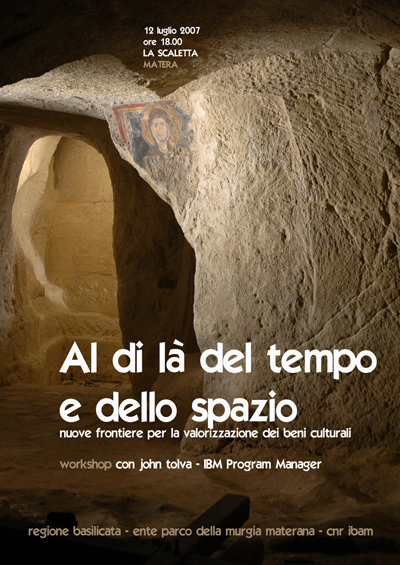
From the poster it looks like I will be lecturing inside of Yoda’s hut on Dagobah. In fact I’ll be speaking to university students and cultural heritage professionals on the topic of … um, “nuove frontiere per la valorizzazione dei beni culturali”. Duh. Have some work to do before Friday.
(Matera is an amazing city, by the way. Much more on it to come …)
Of orphans, the dead, and a house on a street that does not exist
Last weekend the boys and I set off on the last major pre-Italy fact-gathering adventure. Actually it was kinda morbid or, at least, odd for a five- and three-year-old. The goal was to visit my great-grandparents’ residence in Little Italy, the cemetery where they are buried, and the orphanage where my grandfather grew up. Why? Not entirely sure. Not a lot of facts to be gathered at these places frankly. I guess I just had to see.
We started in the massive, mostly-Italian cemetery of Our Lady of Mount Carmel. It is a Roman phonebook written in weathered stone.
We hunted around the graves with a crappy map. It was sweltering. And we were being pummeled by sex-crazed cicadas. But the boys were troopers. Nathan said “So, Dad. Everybody’s dead here?”
“Yes, all dead.”
“Why are they in the ground?”
Didn’t have a great answer for that one.
We got the map in the sprawling mausoleum which really freaked out the boys. Except occasionally for soft strains of angelic choirs coming from somewhere it was supernaturally quite — a situation my children have never experienced. Also the smell. Not quite rancid, but certainly not right. We got outta there quickly.
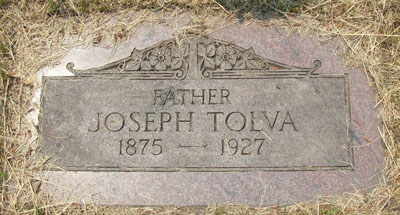
Back to the grave hunt. Basically Giuseppe Tolva doesn’t have a very elaborate grave, which is why it took us forever to find it. Most graves have upright markers and are visible from the cemetery roads, but his is flat with the ground all the way in the back of the vertical tombstones. I’d love to know who paid to inter him here and even more to know who put the artificial flower on the headstone. Interestingly there is no marker for his mistress nearby as we were led to believe. Just a joint grave for his two daughters.
The heat and bug assault was too much so we had to cut our hunt short for Grace, his wife. We decamped for Maryville Academy, the orphanage my grandfather grew up in when Grace died in childbirth with his brother. Frankly it was more depressing than the graveyard and even harder to grasp for my kids than the corpses in the ground.
“You mean the kids here have no parents? Why not?”
“Well some of them are dead and in the ground.”
The boys’ eyes enlarge to the size of silver dollars.
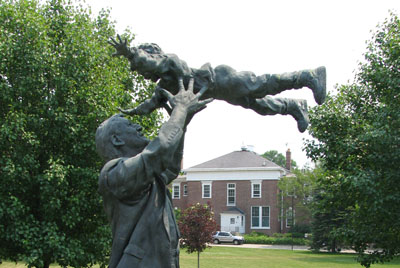
Actually Maryville isn’t an orphanage anymore. It serves physically, sexually and emotionally abused and neglected children. The old building, the beloved home of my grandfather (he maintained a relationship with the staff there all his life), is in sorry shape. It looks a bit like a dilapidated southern plantation house. The heat and cicadas made it feel all the more so. But still it felt like it could have been a good place for my grandfather. You’d not have been surprised to turn a corner and see this Maryville scene on a park bench. (Photo of my great-grandfather, great-uncle, and great-aunt circa 1920.)
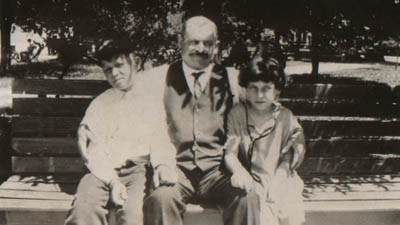
Back into the city with two very tired boys. The heat-spawned rain was starting to fall as we headed into Little Italy. I had recently found Giuseppe’s World War I draft registration card which contained an important (and unknown) reference to his residence at the time: 908 Sholto. It was in his own scrawl so I figured I was reading it wrong. Never heard of such a street in Chicago. So I found a list of all the streets. Nope, no Sholto. Great, doesn’t exist. Or maybe the UIC construction in the 1960’s destroyed it? Turns out, the street had only been renamed. 908 Sholto is actually 908 S. Carpenter.
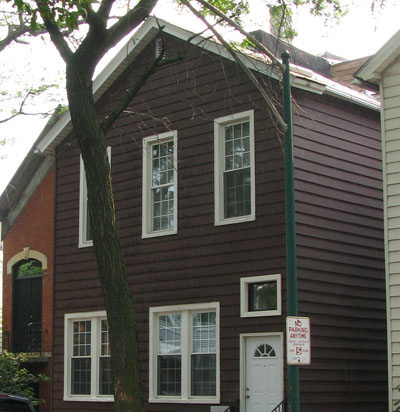
The kids had fallen asleep in the car by this point. It was pouring rain and I was prowling around the east edge of Little Italy looking a little suspicious. I’m pretty sure the home at 908 S. Carpenter is not the same one Giuseppe and Grazia lived in, but you never know. There are plenty of buildings that have stood that long. I have to believe they were crammed in there with other immigrants.
Yep, I guess I just had to see.
From Movable Type to movable type
On the flight to St. Petersburg I listened to the podcast of a session I missed at SXSW called From Blog to Book (audio). It was, duh, about turning one’s blog into a book. Now, don’t panic, I’m not naïve enough to assume that the content of this blog is worthy of bookdom. Seriously, I know. Nor do I assume that the number of readers of this blog constitutes enough of a market to make a print-run viable. But still. One can dream.
The upcoming trip to Barile just seems to me so apt for linear exposition, either as a series of articles or as a book. Why would it make a good story, you ask? Well, consider that I am hauling myself and my not-so-worldly parents across the ocean to a remote corner of Italy merely on the invitation of a municipal council whose only e-mail to me reads:
Dear Sir John Tolve, we’re the “Pro-Loco” of Barile in the province Potenza, Italy. We wold like to invite you to a conference and we want establish it (date) with your business. This event will be held next summer and we wish to award you for your activities developed in USA. As we are very prond of your “Barilese” origins and we would like to spend a celebration day with you. We are looking forevard to receive your news
My reply and subsequent re-replies have all bounced back because of a too-full mailbox in Barile.
Now, of course I’ve been in contact with others — a representative of the regional government, a family friend who is a travel agent in the area, a work colleague outside of Naples, and an Italian cousin whose coming in from Holland — but none of them really know what’s going on or what’s going to happen in Barile. This in itself I find interesting. As in, what the hell am I doing leaving my wife and children in Chicago to go to Italy for “a celebration day”? Might make a good start to a book, no? A mystery-travelogue of sorts.
So back to the podcast From Blog to Book. My expectations were fairly low since, let’s face it, not that many great bloggers have become great print writers. What esteemed example do they have on the panel? That’d be Tucker Max, author of tuckermax.com, one of the most offensively, hilariously puerile sites on the ‘tubes. Basically Tucker is a decent writer with an insatiable libido, a love of reckless inebriation, and zero moral qualms. As you might imagine, the session wasn’t exactly loaded with tips for aspiring writers because, well, humanity being what it is, anyone who can write well about drunken sex is bound to do pretty well for himself. As I do not plan on drunken sex in Italy (“day of celebration”, eh?) I am lacking a critical component of this sure-fire formula for success.
But I’d still like to try. Not sure where to begin (other than this blog, of course). Suggestions welcome. I know some of you out there have been published!
Of course, we’ll have to see what happens in Italy. My money is on the unexpected.
T-minus 3 weeks, 1 day.
Arbëreshë
A leading freedom fight dies in a war between faiths, west and east. Thousands of refugees flee to a neighboring country. Sound familiar?
This is Albania, 15th century. The Ottoman empire has amassed the largest army the world has known and is inching westward into Europe. The town of Krujë is under siege and has repelled two assaults under the command of George Kastrioti, known as Skanderbeg. During a third siege Skanderbeg succumbs to malaria. Krujë falls shortly thereafter and the Ottoman empire expands. Albania’s long resistance has given Vienna time to prepare, but the Turks are on the march.
In the next century nearly 300,000 Albanians fled their homeland, most to southern Italy. Modern Italy retains a link to Albania through the descendants of these refugees who established villages throughout the south. Barile, the birthplace of my great-grandparents, is one of these villages.
These Italians of Albanian descent are known as the Arbëreshë. They speak a language that’s basically unintelligible to modern Albanians (and of course Italians). It is the language of pre-Ottoman Albania, roughly equivalent to someone today speaking 15th century English in conversation. Despite not officially being classified as a protected ethnic minority in Italy, the Arbëreshë have retained customs and rites through to today, including a very peculiar singing style.

When I visited Barile in 1993 all the town signage was in Italian exclusively. In 2003 it was bilingual with Arbërisht underneath. I take this more as a tourist play than any kind of ethnic resurgence. Still, a good thing. As I’ve said before, the diversity of the south of Italy can be quite surprising, permitting glimpses into non-Roman cultures that you don’t find in the hills of Tuscany and alleys of Rome.
Of course, the struggles in Albania and the former Yugoslavia continue today. As does the exodus of refugees to Italy, particularly after the fall of communism. The most recent flight is excellently portrayed in the film Lamerica.
The ultimate social network
It is said that researching family history is second only to scouring the web for porn in popularity. I’m not sure if that’s true, but I can see how it might be so. If ever there was a medium perfectly suited to establishing lineage and contact with unknown family it is the Internet.
I’ve always had a simmering interest in genealogy, but the sorry state of family tree applications never got me very excited. These were almost always legacy beasts that could import the archaic GEDCOM standard file format and do little more. Where these apps really failed was in areas of collaboration and visualization. What good is a family tree if you are the only person who can work on it? And, much thornier, how do you slice and dice such a fractal dataset so that it is actually useful?
In recent years Ancestry.com has stepped in and taken care of much of the problem. Ancestry is run by the Church of Latter Day Saints (the Mormons) as a commercial offshoot of their ginormous genealogical holdings. The site is strictly secular though and offers an amazing array of backend research services that turns one’s offline family tree into a portal to dozens of historical record repositories. Just upload (or enter) what you know and the site begins searching census records, immigration manifests, military archives — and the best of all, other people’s trees that link up with yours back in the mists of time. Depending on where you’re from you can flesh out your family rather easily. Just a few nights ago I actually got bored after taking my mom’s mom’s line back so far through the UK that my line proceeded through a reverse Norman invasion back to France in the 11th century. Goodness knows how far back the recorded lineage goes.
Perhaps the most entertaining feature of Ancestry.com is the “Find Famous Relatives” function, six-degrees of separation on steroids. Basically if you have a pretty fleshed-out tree (and especially if any branches of it stretch back through the UK), Ancestry returns a bewildering collection of well-known relatives. For instance, I am the seventh cousin twice removed from William Faulker. This means ol’ Will and I share the same great-great-great-great-great-great-grandparent, though this person is two generations off from me. (Twice removed is what you are to the first cousins of your grandparents.) Not exactly thrilling. Ah, but there is thrill. I am the twelfth direct cousin of Werner Von Braun. This means we share the same great-grandmother12. Let’s set aside that Herr Von Braun developed the V2 rocket for the Nazis and instead focus on his role as the father of the American space program, OK?
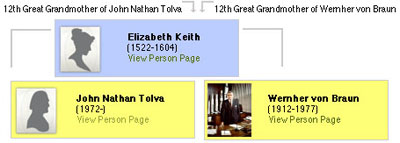
Even before I found Ancestry.com the web has been an inadvertent boon to family-finding. All you really have to do is get your name indexed by Google and it is off to the races. In the last six years I’ve been contacted by dozens of people with similar surnames or lineages who think they might be family. There’s Roberto di Tolve, a citizen and resident of Holland who was born in Barile, Italy and who is now a close family friend. Roberto travelled to Barile with my family and I in 2003. He’ll be back with us this July. There’s Stephanie Saville of the Paternoster line who traces her line to the famous winemakers of Barile. Most recently there’s Mike Botte who lives in NY and who grew up in Barile. (My great-grandmother is a Botte.) This may be the closest to true relation that’s been established simply from an e-mail. Mike’s cousin is the current mayor of Barile, who I will meet in July; so we’ll know soon. Much more on Mike and his extraordinary brother John in a future post.
So, ok, you get it. Online genealogy can be fun. But I am already seeing the underside of it. For one, it really does make you think hard about what family is. Genealogy is really about bloodlines, not family in the broader sense which includes step-relatives, foster parents, and illegitimacy. It charts gene propagation not family structure. In this way it is conceptually similar to The Genographic Project.
Also, you do come across people who treat genealogy with the same trainspotting zeal as online discographers. For example, finding a limited pressing of a Rolling Stones LP with a typo in the liner notes makes it more valuable; finding a misspelling on an emigration document might be a useful clue — but it might also be (and usually is) merely a massive pain in the ass. There’s a kind of genealogy buff I’ve come across that doesn’t really get this distinction.
Hi, I’m John Tolva!
Mission Elapsed Time: 20:00:21:06:42:40
Recently this blog (and my Flickr account) turned 20 years old, forever in Internet years. I went back through it all, retracing digital footprints made on what feels like a different planet. Here are some highlights.
The Terror Tourist
A roughly monthly exploration of places in horror fiction — real or imagined, geographical or psychological — culled from The Heavy Leather Horror Show.
Subscribe to the podcast or the email newsletter or just read through the archives posted here.
The Ampcamper
How I hauled myself, two teens, an 80 lb dog, and a whole load of crap 4000+ miles across six states in twenty days using an electric vehicle. And survived to tell the tale.
Latest Photos
Marginalia
Stuff I’ve found interesting from around the web lately.
The Bureau of Linguistical Reality
Alicia Escott’s artistic thinking focuses on grappling with what it is to live a human life amid a moment that is profoundly rare in the geologic and ecologic history of the planet.
A Mystery in the Shape of a Book
On a gravel road outside of Cheyenne, Wyoming, I stood before a Little Free Library painted the colors of the Pride flag.
The Great Resegregation
The Trump administration’s attacks on DEI are aimed at reversing the civil-rights movement. Produced by ElevenLabs and News Over Audio (Noa) using AI narration. Listen to more stories on the Noa app.
Steal My Tesla
Don't waste any more time trying to sell your Tesla. We'll take it from here... Having difficulty selling your Tesla without all the hassle and negativity? Maybe its time to consider other options.
A Memorandum from the Newly Established Department of Grammar Efficiency
The federal Government is eliminating inefficient grammar. NO ONE understands how to properly use an em-dash or semicolon. Therefore, those types of punctuation are now ELIMINATED to protect hard-working American Citizens from further confusion. YOUR WELCOME.
What does Maga-land look like? Let me show you America’s unbeautiful suburban sprawl
In 1941 Dorothy Thompson, an American journalist who reported from Germany in the lead-up to the second world war, wrote an essay for Harper’s about the personality types most likely to be attracted to Nazism, headlined “Who Goes Nazi?” “Those who haven’t anything in them to tell them what
Bad at Goodbyes
On today’s show we learn about the Casey’s Larkspur, a critically endangered perennial herb native to the Kyrenia Mountains in northern Cyprus, an island in the east of the Mediterranean sea. Please find us on the web at Bad at Goodbyes and on instagram.
Yes, Paris has its own bicycle hearse and so does the United Kingdom
In the burgeoning bicycle city of Paris, France, those looking for a more gentle, environmentally friendly funeral service now have the option of a hearse powered by a cargo bike.
The Retro Subway Map That Design Nerds Love Makes a Comeback
When it comes to the New York City subway, what once was old is new again.
Bringing Italo Calvino’s Invisible Cities to life with AI
If you’ve ever read Italo Calvino’s Invisible Cities, it is not your typical book about urban landscapes.














